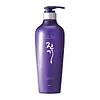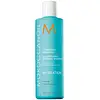What's inside
What's inside
 Key Ingredients
Key Ingredients

 Benefits
Benefits

 Concerns
Concerns

 Ingredients Side-by-side
Ingredients Side-by-side

Water
Skin ConditioningChrysanthemum Boreale Flower/Leaf/Stem Extract
Skin ConditioningSodium Laureth Sulfate
CleansingSodium Lauryl Sulfate
CleansingRehmannia Glutinosa Root Extract
Skin ConditioningThuja Orientalis Leaf Extract
AntioxidantArtemisia Vulgaris Extract
Skin ConditioningCocamidopropyl Betaine
CleansingDimethicone
EmollientGleditsia Japonica Fruit Extract
Skin ConditioningMorus Alba Bark Extract
Skin ConditioningEclipta Prostrata Extract
Skin ConditioningPEG-7 Glyceryl Cocoate
EmulsifyingAcorus Calamus Rhizome Water
Skin ConditioningParfum
MaskingCnidium Officinale Root Extract
Skin ConditioningCocamide Mea
EmulsifyingDecylene Glycol
Skin ConditioningSodium Chloride
MaskingCarbomer
Emulsion StabilisingSodium Cocoyl Alaninate
Triethanolamine
BufferingPEG-10
HumectantGuar Hydroxypropyltrimonium Chloride
Skin ConditioningPropylene Glycol
HumectantMenthol
MaskingHydroxyacetophenone
AntioxidantLactobacillus/Centella Asiatica/Gleditsia Sinensis Thorn/Houttuynia Cordata Extract/Phellodendron Amurense Bark/Polygonum Cuspidatum Root/Prunella Vulgaris/Torilis Japonica Extract Ferment Filtrate
Skin ConditioningPanax Ginseng Root Extract
EmollientDisodium EDTA
Panthenol
Skin ConditioningButylene Glycol
HumectantCitric Acid
BufferingLauramine Oxide
CleansingOak Vinegar
Skin ConditioningHydrolyzed Keratin
HumectantPortulaca Oleracea Extract
Skin ConditioningSodium Benzoate
MaskingPhenoxyethanol
PreservativeLinalool
PerfumingAlpha-Isomethyl Ionone
PerfumingLimonene
PerfumingHexyl Cinnamal
PerfumingCitronellol
PerfumingWater, Chrysanthemum Boreale Flower/Leaf/Stem Extract, Sodium Laureth Sulfate, Sodium Lauryl Sulfate, Rehmannia Glutinosa Root Extract, Thuja Orientalis Leaf Extract, Artemisia Vulgaris Extract, Cocamidopropyl Betaine, Dimethicone, Gleditsia Japonica Fruit Extract, Morus Alba Bark Extract, Eclipta Prostrata Extract, PEG-7 Glyceryl Cocoate, Acorus Calamus Rhizome Water, Parfum, Cnidium Officinale Root Extract, Cocamide Mea, Decylene Glycol, Sodium Chloride, Carbomer, Sodium Cocoyl Alaninate, Triethanolamine, PEG-10, Guar Hydroxypropyltrimonium Chloride, Propylene Glycol, Menthol, Hydroxyacetophenone, Lactobacillus/Centella Asiatica/Gleditsia Sinensis Thorn/Houttuynia Cordata Extract/Phellodendron Amurense Bark/Polygonum Cuspidatum Root/Prunella Vulgaris/Torilis Japonica Extract Ferment Filtrate, Panax Ginseng Root Extract, Disodium EDTA, Panthenol, Butylene Glycol, Citric Acid, Lauramine Oxide, Oak Vinegar, Hydrolyzed Keratin, Portulaca Oleracea Extract, Sodium Benzoate, Phenoxyethanol, Linalool, Alpha-Isomethyl Ionone, Limonene, Hexyl Cinnamal, Citronellol
Water
Skin ConditioningSodium Lauroyl Sarcosinate
CleansingCocamidopropyl Hydroxysultaine
CleansingCocamidopropyl Betaine
CleansingParfum
MaskingLactamide Mea
HumectantGlycerin
HumectantAcrylates/Palmeth-25 Acrylate Copolymer
Argania Spinosa Kernel Oil
EmollientChondrus Crispus Extract
Skin ConditioningAscophyllum Nodosum Extract
Skin ConditioningLaminaria Saccharina Extract
Skin ProtectingPalmaria Palmata Extract
Skin ProtectingUndaria Pinnatifida Extract
Skin ConditioningXylitylglucoside
HumectantPEG-150 Pentaerythrityl Tetrastearate
EmulsifyingAnhydroxylitol
HumectantSodium PCA
HumectantStyrene/Acrylates Copolymer
PEG-6 Caprylic/Capric Glycerides
EmulsifyingCitric Acid
BufferingLauric Acid
CleansingPolyquaternium-7
Propylene Glycol
HumectantXylitol
HumectantSodium Sarcosinate
Tetrasodium EDTA
Polysorbate 20
EmulsifyingDisodium EDTA
Ethylhexylglycerin
Skin ConditioningPEG-20 Glyceryl Laurate
EmulsifyingGlucose
HumectantTocopherol
AntioxidantLinoleic Acid
CleansingRetinyl Palmitate
Skin ConditioningCaprylic/Capric Triglyceride
MaskingDiethylhexyl Syringylidenemalonate
Skin ProtectingPhenoxyethanol
PreservativeSodium Benzoate
MaskingPotassium Sorbate
PreservativeChlorphenesin
AntimicrobialAlpha-Isomethyl Ionone
PerfumingLinalool
PerfumingHydroxycitronellal
PerfumingWater, Sodium Lauroyl Sarcosinate, Cocamidopropyl Hydroxysultaine, Cocamidopropyl Betaine, Parfum, Lactamide Mea, Glycerin, Acrylates/Palmeth-25 Acrylate Copolymer, Argania Spinosa Kernel Oil, Chondrus Crispus Extract, Ascophyllum Nodosum Extract, Laminaria Saccharina Extract, Palmaria Palmata Extract, Undaria Pinnatifida Extract, Xylitylglucoside, PEG-150 Pentaerythrityl Tetrastearate, Anhydroxylitol, Sodium PCA, Styrene/Acrylates Copolymer, PEG-6 Caprylic/Capric Glycerides, Citric Acid, Lauric Acid, Polyquaternium-7, Propylene Glycol, Xylitol, Sodium Sarcosinate, Tetrasodium EDTA, Polysorbate 20, Disodium EDTA, Ethylhexylglycerin, PEG-20 Glyceryl Laurate, Glucose, Tocopherol, Linoleic Acid, Retinyl Palmitate, Caprylic/Capric Triglyceride, Diethylhexyl Syringylidenemalonate, Phenoxyethanol, Sodium Benzoate, Potassium Sorbate, Chlorphenesin, Alpha-Isomethyl Ionone, Linalool, Hydroxycitronellal
 Reviews
Reviews

Ingredients Explained
These ingredients are found in both products.
Ingredients higher up in an ingredient list are typically present in a larger amount.
Alpha-Isomethyl Ionone is a fragrance. It can be synthetically created or naturally occurring.
The scent of Alpha-Isomethyl Ionone is described as "flowery" but can also be "woody".
Naturally occurring Alpha-Isomethyl Ionone may be found in Saccharomyces cerevisiae, or the yeast used to make wine and bread.
The term 'fragrance' is not regulated in many countries. In many cases, it is up to the brand to define this term. For instance, many brands choose to label themselves as "fragrance-free" because they are not using synthetic fragrances. However, their products may still contain ingredients such as essential oils that are considered a fragrance.
Learn more about Alpha-Isomethyl IononeCitric Acid is an alpha hydroxy acid (AHA) naturally found in citrus fruits like oranges, lemons, and limes.
Like other AHAs, citric acid can exfoliate skin by breaking down the bonds that hold dead skin cells together. This helps reveal smoother and brighter skin underneath.
However, this exfoliating effect only happens at high concentrations (20%) which can be hard to find in cosmetic products.
Due to this, citric acid is usually included in small amounts as a pH adjuster. This helps keep products slightly more acidic and compatible with skin's natural pH.
In skincare formulas, citric acid can:
While it can provide some skin benefits, research shows lactic acid and glycolic acid are generally more effective and less irritating exfoliants.
Most citric acid used in skincare today is made by fermenting sugars (usually from molasses). This synthetic version is identical to the natural citrus form but easier to stabilize and use in formulations.
Read more about some other popular AHA's here:
Learn more about Citric AcidCocamidopropyl Betaine is a fatty acid created by mixing similar compounds in coconut oil and dimethylaminopropylamine, a compound with two amino groups.
This ingredient is a surfactant and cleanser. It helps gather the dirt, pollutants, and other impurities in your skin to be washed away. It also helps thicken a product and make the texture more creamy.
Being created from coconut oil means Cocamidopropyl Betaine is hydrating for the skin.
While Cocamidopropyl Betaine was believed to be an allergen, a study from 2012 disproved this. It found two compounds in unpure Cocamidopropyl Betaine to be the irritants: aminoamide and 3-dimethylaminopropylamine. High-grade and pure Cocamidopropyl Betaine did not induce allergic reactions during this study.
Learn more about Cocamidopropyl BetaineDisodium EDTA plays a role in making products more stable by aiding other preservatives.
It is a chelating agent, meaning it neutralizes metal ions that may be found in a product.
Disodium EDTA is a salt of edetic acid and is found to be safe in cosmetic ingredients.
Learn more about Disodium EDTALinalool is a fragrance and helps add scent to products. It's derived from common plants such as cinnamon, mint, citrus, and lavender.
Like Limonene, this ingredient oxidizes when exposed to air. Oxidized linalool can cause allergies and skin sensitivity.
This ingredient has a scent that is floral, spicy tropical, and citrus-like.
Learn more about LinaloolParfum is a catch-all term for an ingredient or more that is used to give a scent to products.
Also called "fragrance", this ingredient can be a blend of hundreds of chemicals or plant oils. This means every product with "fragrance" or "parfum" in the ingredients list is a different mixture.
For instance, Habanolide is a proprietary trade name for a specific aroma chemical. When used as a fragrance ingredient in cosmetics, most aroma chemicals fall under the broad labeling category of “FRAGRANCE” or “PARFUM” according to EU and US regulations.
The term 'parfum' or 'fragrance' is not regulated in many countries. In many cases, it is up to the brand to define this term.
For instance, many brands choose to label themselves as "fragrance-free" because they are not using synthetic fragrances. However, their products may still contain ingredients such as essential oils that are considered a fragrance by INCI standards.
One example is Calendula flower extract. Calendula is an essential oil that still imparts a scent or 'fragrance'.
Depending on the blend, the ingredients in the mixture can cause allergies and sensitivities on the skin. Some ingredients that are known EU allergens include linalool and citronellol.
Parfum can also be used to mask or cover an unpleasant scent.
The bottom line is: not all fragrances/parfum/ingredients are created equally. If you are worried about fragrances, we recommend taking a closer look at an ingredient. And of course, we always recommend speaking with a professional.
Learn more about ParfumPhenoxyethanol is a preservative that has germicide, antimicrobial, and aromatic properties. Studies show that phenoxyethanol can prevent microbial growth. By itself, it has a scent that is similar to that of a rose.
It's often used in formulations along with Caprylyl Glycol to preserve the shelf life of products.
Propylene Glycol is an odorless, colorless liquid. As a humectant, it helps skin retain moisture. It also aids in delivering active ingredients.
Another role of this ingredient is preventing a product from melting or freezing. Propylene glycol also adds antimicrobrial properties to a product, elongating product lifespan.
This ingredient is considered an organic alcohol and commonly added into both cosmetics and foods.
Those with sensitive skin or conditions may develop a rash when using this ingredient.
Learn more about Propylene GlycolSodium Benzoate is a preservative. It's used in both cosmetic and food products to inhibit the growth of mold and bacteria. It is typically produced synthetically.
Both the US FDA and EU Health Committee have approved the use of sodium benzoate. In the US, levels of 0.1% (of the total product) are allowed.
Sodium benzoate works as a preservative by inhibiting the growth of bacteria inside of cells. It prevents the cell from fermenting a type of sugar using an enzyme called phosphofructokinase.
It is the salt of benzoic acid. Foods containing sodium benzoate include soda, salad dressings, condiments, fruit juices, wines, and snack foods.
Studies for using ascorbic acid and sodium benzoate in cosmetics are lacking, especially in skincare routines with multiple steps.
We always recommend speaking with a professional, such as a dermatologist, if you have any concerns.
Learn more about Sodium BenzoateWater. It's the most common cosmetic ingredient of all. You'll usually see it at the top of ingredient lists, meaning that it makes up the largest part of the product.
So why is it so popular? Water most often acts as a solvent - this means that it helps dissolve other ingredients into the formulation.
You'll also recognize water as that liquid we all need to stay alive. If you see this, drink a glass of water. Stay hydrated!
Learn more about Water